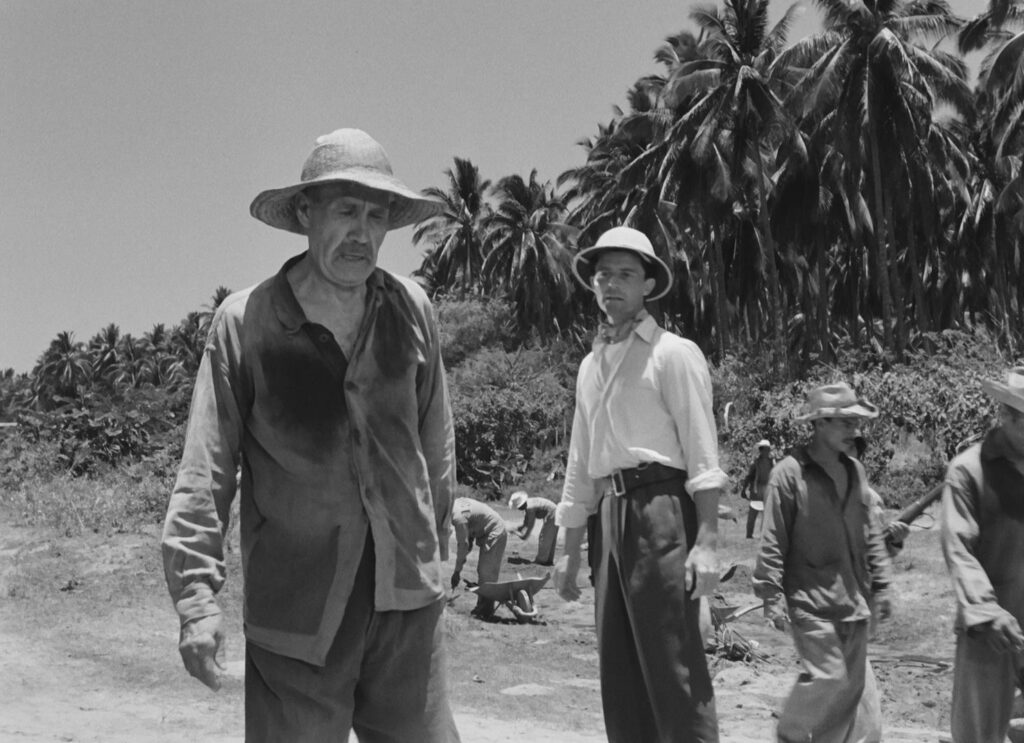
Fever Mounts at El Pao
1959, directed by Luis Buñuel
The last shot of Fever Mounts at El Pao may not go down in film history as one of the most complicated shots ever realized, but it’s intricate enough that we should trust that it builds carefully to a desired ending. It goes on for 66 seconds, and it required Buñuel and his crew to coordinate multiple camera movements, the interwoven paths of Gérard Philipe and a couple dozen prisoners and guards, and the exact lighting needed for a quick fade-out. As complex as the shot is, however, its last seconds simplify the picture rapidly as its content is stripped away. The last guards march out of sight, protagonist Ramón Vázquez walks through a passageway from sunlight into shadows, and a fade-out reduces the scene to the columns and archway of the government palace then finally to the white scraps of paper that Vázquez just threw on the ground.
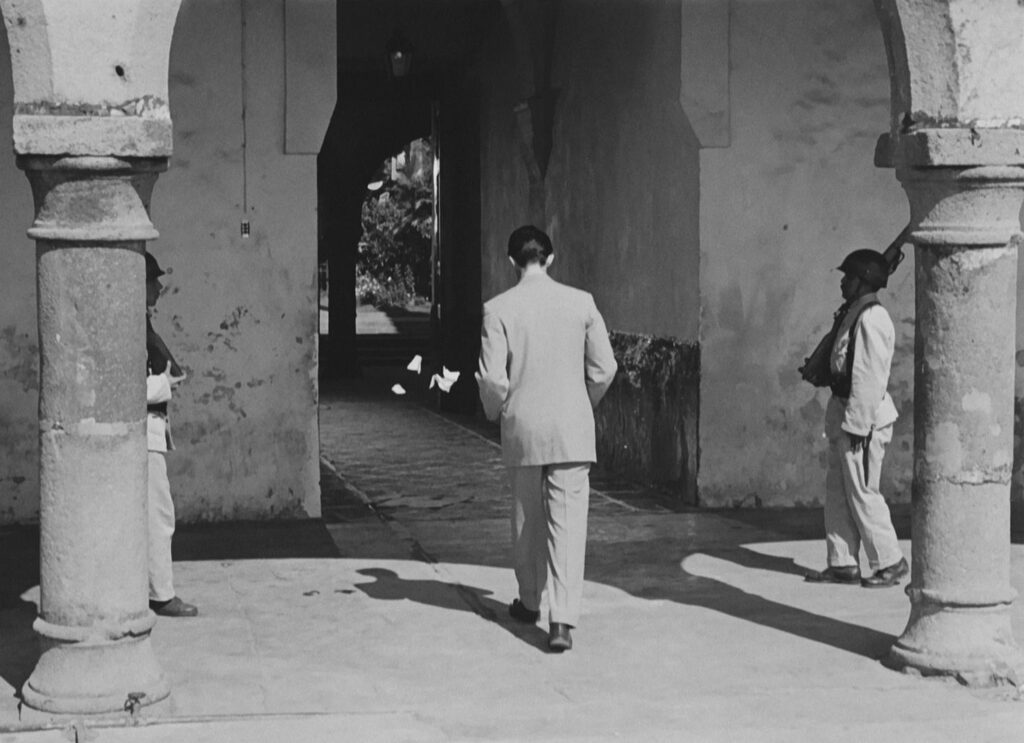
As Vázquez walks away a voice-over puts a closing point on the story: “He had sacrificed everything for his ideals. Everything he hated, admired, and loved. But he wanted to go further. That torn paper, the stubborn refusal to accept an unacceptable order, is a sign of both one’s own death and one’s freedom. Ramón Vázquez’s destiny was fulfilled.” By this point we should already know that the movie is about a failure of idealism. From beginning to end we’ve watched Vázquez gradually betray his youthful progressivism as he rises from secretary to chief of security to governor of the fictional island of Ojeda. It’s a sad process of interpellation, and instead of realizing his ambitions to improve the province he becomes responsible for numerous injustices and the deaths of an admired professor, the preceding governor, the woman he loves, almost 500 political prisoners, and many rebels. His final compassionate gesture, unchaining a new batch of prisoners in defiance of the president’s order, is incongruously feeble compared to the damage he’s done.
From this point of view the movie looks like a cynical account of politics and human nature. We might imagine a more noble course of action for Ramón Vázquez, but we also understand that the force of corruption is sneaky and can defeat even a strong conscience when men and women play with power. When we’re told that Vázquez has fulfilled his destiny it’s almost a note of despair, and the movie looks like little more than a bleak warning.
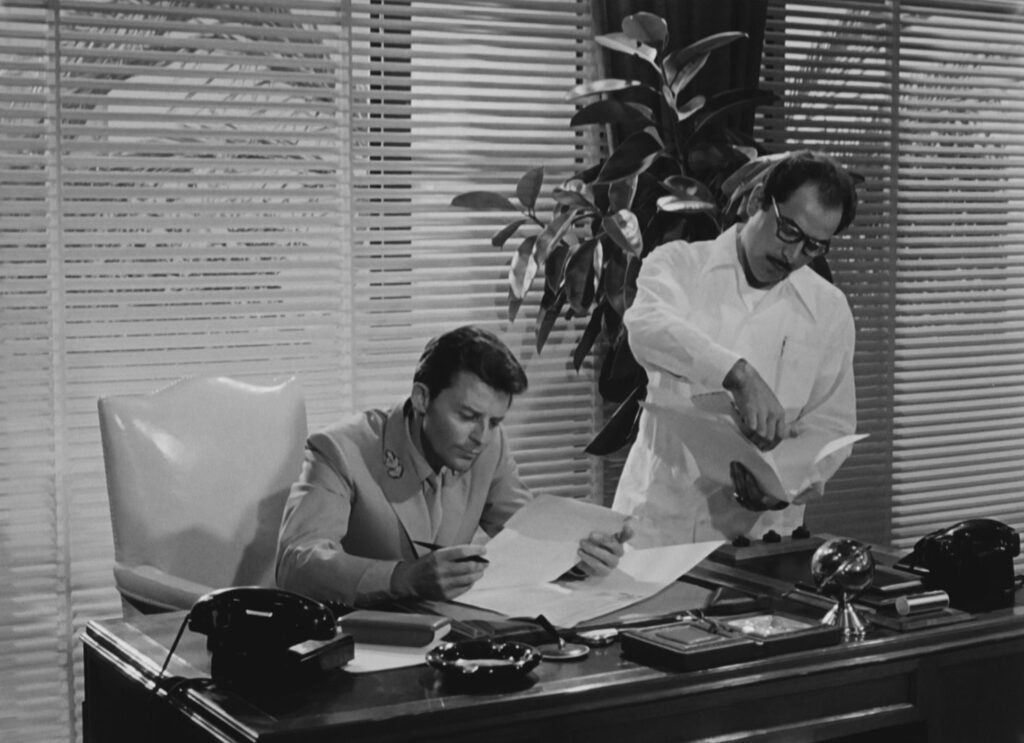
However, if we take a different cue from the last lines and pay attention to the closing of that carefully choreographed final shot, we can find a more constructive purpose in the story. Let us imagine for a moment that it’s not so much a tale of compromised ideals but rather a story of paper. The voice-over calls attention to “that torn paper” which is also the last thing we see, and for that matter the movie also begins with paper – a printed map of Ojeda under the opening titles. Paper makes a conspicuous appearance roughly 19 times across the film, almost at regular intervals, and it’s nearly always tainted. Vargas, the first governor, ransacks Vázquez’s office in a jealous rage, tossing papers all over and seizing a hand-drawn portrait of his wife. In the assassination scene Vargas holds the notes for his speech, which is all lies. Guards hold lists of political prisoners on clipboards. Professor Cárdenas sketches a map of the planned riot that will soon cost him his life. While Gual is being executed his only two friends in the world divvy up a wad of banknotes from his coat pocket. Inés signs a false statement that will bring down the vice president. In the final minutes Vázquez’s secretary shows him an order from President Barreiro mandating harsher treatment of political prisoners.
The plot revolves around a particular piece of paper, a signed statement coerced from Lieutenant García implicating Vázquez as a collaborator in Vargas’s assassination. Originally meant by Gual to blackmail Inés and take her from Vázquez, it becomes a contributory cause of the gulag riot, Gual’s execution, the deaths of Inés and her driver, and the maintenance of a dictator’s power. Most of the paper in this movie is sinister, but this document exceeds the rest, and after Inés rips it up a second copy surfaces in the files of Sáenz, the minister of the interior. Paper may be easy to destroy, but its destructive power endures.
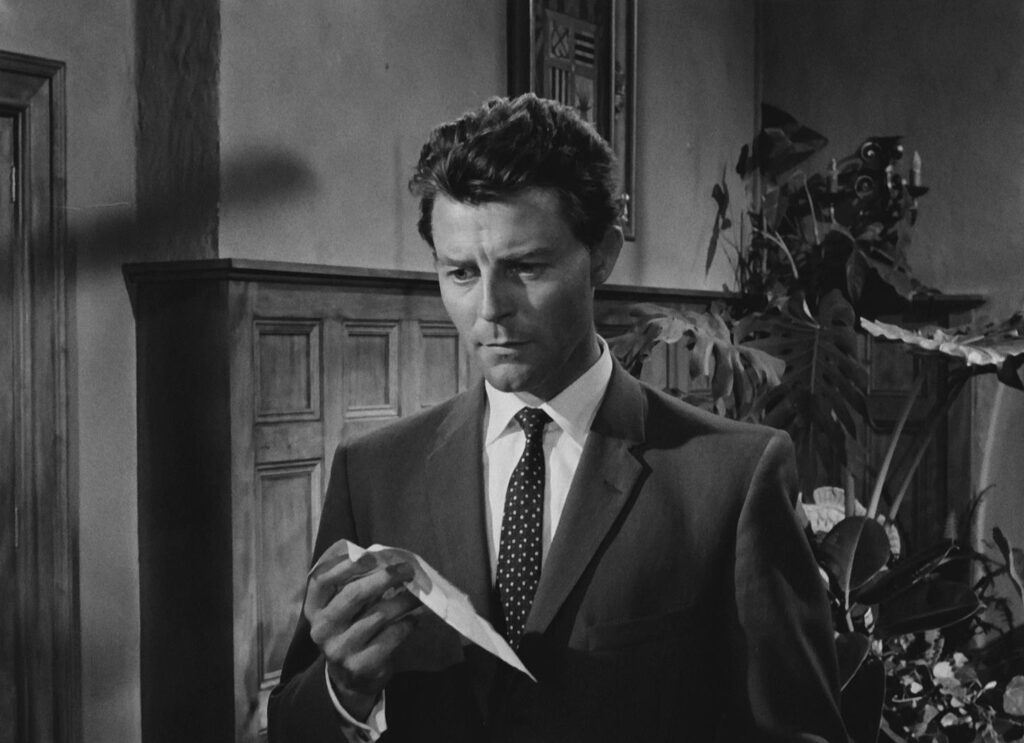
Once we view Fever Mounts at El Pao through this lens, as a story about paper, it no longer looks cynical. Rather than shaking its head at the easy corruptibility of human nature, it reveals an understanding of politics that could help to lessen corruption. It’s not that paper itself is the enemy – it’s that paper distances persons in power from the real world they’re supposed to govern. Again and again people’s lives are represented and manipulated on paper. Vázquez feels empathy for his former professor and for the prisoners tied to stakes, but it’s harder to summon compassion for hundreds of anonymous prisoners listed on a sheet of paper. A statement of denunciation, a warrant for arrest, or an order for execution may have monstrous effects, but it’s relatively easy, even for someone who’s not a sociopath, to rationalize signing it. Likewise, it’s easier for a politician to lie to supporters when reading from a prepared text.
Putting the movie in the context of Buñuel’s other work, we can be even more precise about the role of paper here. Most of his films are in one way or another about the dangers of detachment – the tendency, usually of people with privilege, to stand aloof from the life around them. The problem with paper is that it facilitates detachment. It’s tempting to blame Inés and her rationalizations for Vázquez’s gradual corruption, but he shows that he’s willing to defy her in spite of his love. The effect of all the paper around him is more insidious – his misplaced faith in his own draft of reforms, which justifies overlooking momentary injustices toward the prisoners; his pride in his promotion to head of security, which comes on paper as an official decree; his fear of Garcia’s incriminating statement; and the abstract formality of the confession Sáenz wants Inéz to sign, which makes it easier to ignore its political ramifications. In each case paper distances Vázquez from real life.
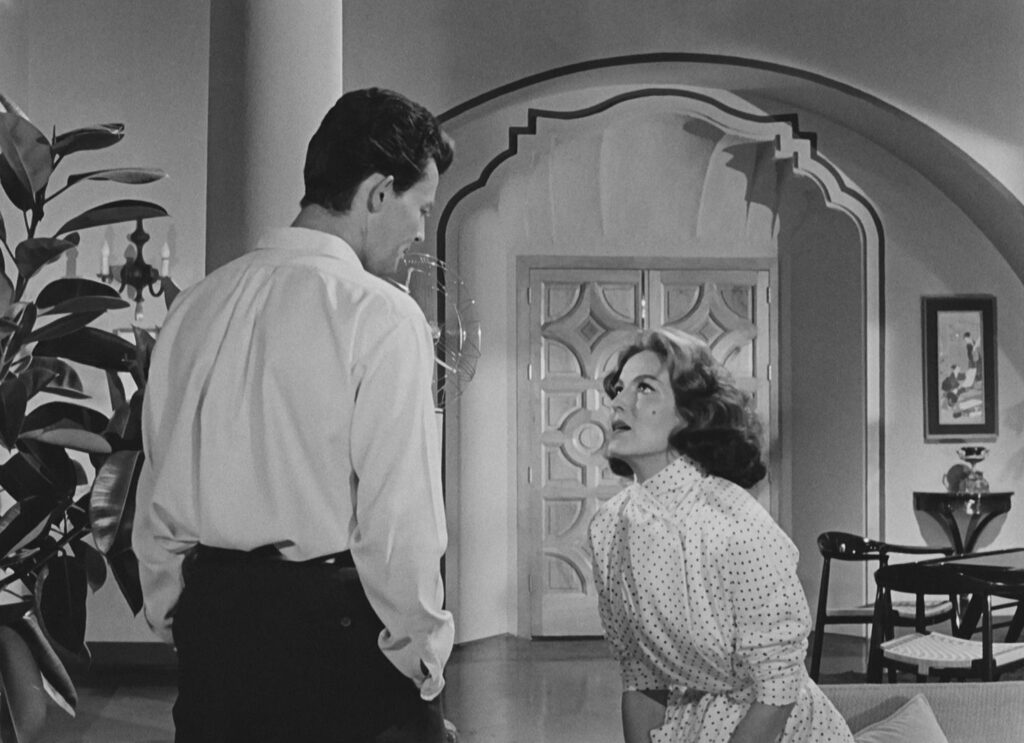
Vázquez is a man of conscience, which makes his corruption more mysterious than that of the guards, officials, ministers, and politicians around him. The insistent use of paper exposes how someone so idealistic can get detached from everything he believes in. No explanation is needed for the corruption of the less conscientious officials, but with them too it’s a matter of detachment. President Barreiro should be interested in the country he’s expected to govern, but instead we find him animated only by power and racehorses. Governor Vargas cares more about his wife’s fidelity than the island’s welfare, and Gual would rather conquer Inés than attend to any pressing matters.
The contest between Gual and Inés reaches its climax in what would appear to be the movie’s weakest scene, the bullfight. The scene feels detached from the rest of the film, and not only because it’s set in the national capital on the American mainland. The scenes with Barreiro and Sáenz also take place on the continent, but the bullfight follows a jarring shot of modern automobiles in a parking lot, nothing like what we’ve seen of Ojeda. The bullfight uses stock footage with obvious rear screen projection, and the unsimulated piercing and death of the bull makes it snuff footage, though at least it certainly wasn’t staged for this particular film. What’s remarkable though is how the power struggle between Gual and Inés matches the action in the ring. When the bull appears to win, knocking down and almost goring the bullfighter, Gual kisses Inés, confident of his final victory; but a few seconds later the bull dies, and the subsequent cut back to Ojeda makes it clear that the bull’s death corresponds to Gual’s own fate being sealed back on the island. Inés has defeated him like a matador slaying a bull.
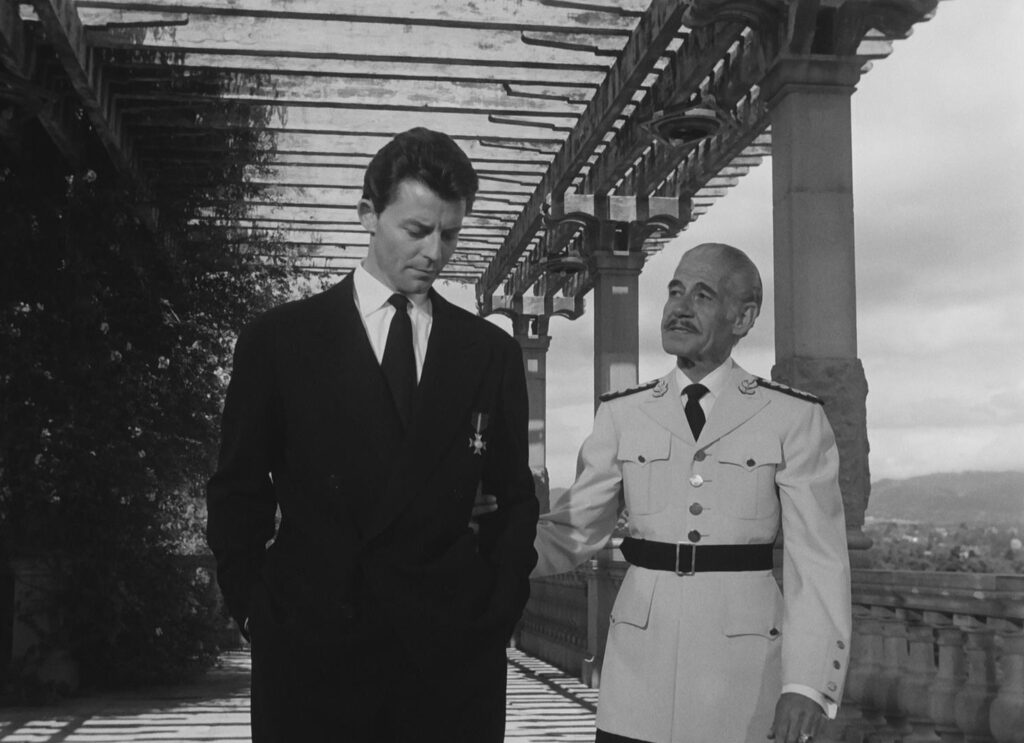
When Vázquez meets Professor Cárdenas’s daughter at her father’s grave, he expresses remorse for the damage he’s done. His conscience is still intact; his corruption has not been an internal degradation, but rather an invisible process of detachment that we can follow if we trace the history of paper across the film. In the final scene his conscience rebels against this tyranny of paper, and he rips up the president’s order and casts it on the ground. The voice-over tells us that this act is simultaneously a sign of both his death and his freedom, but with so many lives destroyed in his wake, any freedom he might enjoy must feel like a bitter consolation.
CONNECTIONS:
Day of Wrath – Uncannily destructive power of words/paper
Gertrud – Destructive effect of words and paper; public speech full of falsehoods (Governor Vargas & Gustav Kanning)
Alphaville – Use of language and abstraction to distance people from real life
Topaz – Destructiveness of seemingly good intentions
The Man Who Left His Will on Film – Abstraction opposed to real experience
Blade Runner – Abstraction opposed to real experience
LIST OF CONSPICUOUS APPEARANCES OF PAPER:
- Map of Ojeda
- Papers Vargas tosses from Vázquez’s desk; Portrait of Inés
- Vargas’s speech
- Register of prisoners; Vázquez’s form to absolve him of responsibility
- Vázquez’s plans to better the administration
- Unidentified papers when Gual snoops in Inés’s room
- Vázquez’s promotion to head of security
- Summons for Inés to see Gual
- García’s statement; Warrant for Vázquez’s arrest
- Cárdenas’s diagram of riot plans
- Inés rips up García’s statement
- Banknotes divided between López and Villa
- Unidentified papers on Vázquez’s desk, likely a report on the riot or Gual’s execution
- Statement for Inés to sign; Duplicate of García’s statement
- Inés’s statement in her hands
- Vázquez’s mail, including president’s order for harsher treatment of political prisoners
- Unidentified papers on Vázquez’s desk, apparently a register of new prisoners
- Register of new prisoners; President’s order when Vázquez first reads it
- Vázquez rips up president’s order